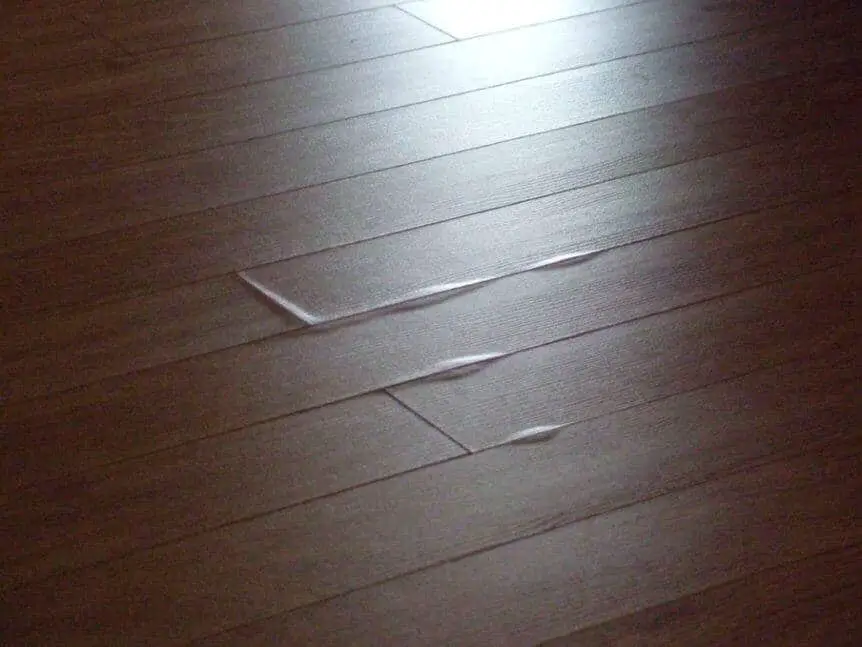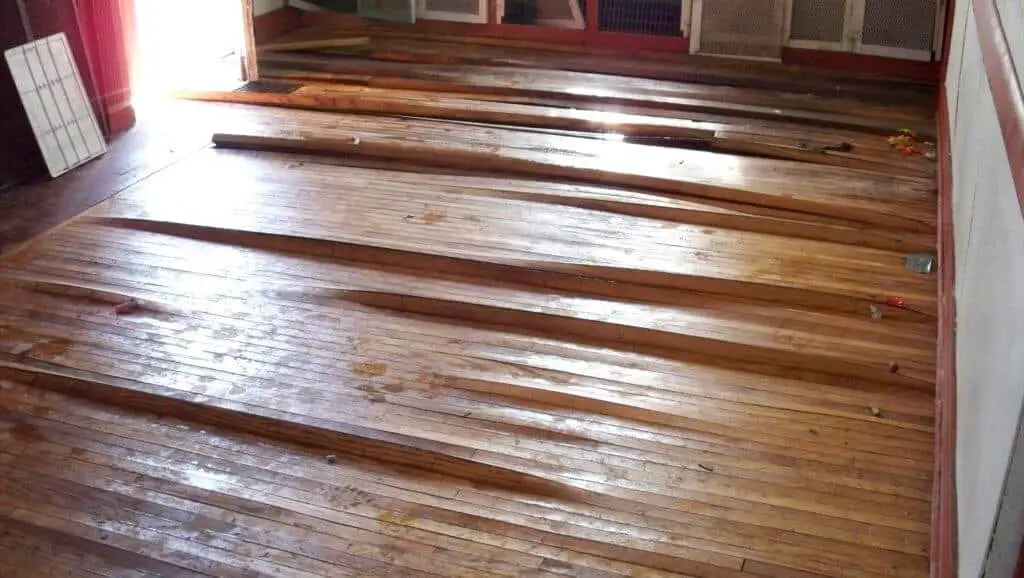Vinyl plank floor is a cheaper but luxurious looking alternative to the all expensive hardwood floor; this cost-effective alternative to hardwood flooring is available in different styles and patterns; they are easy to install and maintain.
However, due to their installation procedure, which is basically a click-together, loose lay, or a glue-down installation, vinyl plank floors are prone to buckling.
If you are experiencing some troubles with it and wondering why your floor is buckling, there are a couple of reasons that could be happening, ranging from wrong installation method to temperature conditions.
Why Is My Vinyl Plank Floor Buckling
Table of Contents
As stated above, there are a couple of reasons your vinyl plank floor is buckling, and here are some of the reasons.
Using Low-Quality Adhesive
During the installation process of vinyl floor, it is crucial that you make use of top quality glue to hold down the planks.
When it comes to adhesive, you want to up your budget and go for a premium high quality one, as they create a more secured bond compared to cheaper alternatives that get loose easily and cause your floor to buckle.
You also want to check the expiry date of the adhesive before purchasing it to avoid getting expired or soon to expire adhesive; you also want to apply the adhesive according to the manufacturer’s instructions in order to achieve the best results.
Moisture
This a leading cause of vinyl floor buckling; if there’s an excessive amount of water seeping from a moist subfloor, it can cause your vinyl floor to buckle because the moisture weakens the adhesive used to hold down the planks.
To prevent this from happening, if you have a concrete subfloor, you can run a vapor barrier underneath the vinyl planks.
Also, you want to go for waterproof vinyl planks to prevent moisture damage, especially if you are installing the vinyl planks in the kitchen, entryway, or bathroom; this is because these areas are more prone to moisture buildup.
So going the extra mile and spending a few couple more bucks for waterproof vinyl planks will save you the stress later on.
Read: How easy is it to lay vinyl floor tile
Exposure To Extreme Weather Conditions
Like most woodlike flooring, vinyl is subjected to expansion and contraction. When vinyl floor is exposed to high temperatures, it can expand. This can easily cause the floor to buckle.
Also, if the vinyl planks are in direct contact with the sun, through a large window or door, the adhesive in that area of exposure begins to release its bond due to the heat, causing the vinyl planks to shift, especially when the vinyl planks have an inner fiberglass layer.
Extreme cold temperatures also have an effect on vinyl floors. The cold can cause the planks to contract, this creates huge gaps between the planks, although overexposure to heat and sunlight has more effect on vinyl flooring compared to cold.
You can reduce the chances of this happening by going for more expensive vinyl materials as they are less likely to buckle compared to inexpensive options.
Read: How to repair swollen laminate floor
Placing Too Much Weight On The Floor
There are different types of vinyl flooring, and each has different installation processes. Not all vinyl plank flooring requires a glue-down installation process.
Some require loose-lay vinyl installation, and this type of installation is quite popular because it an easy process to carry out, and it adds extra durability to your flooring.
However, with this type of installation process, placing or dragging a large and heavy object over the floor surface can cause it to buckle, dragging heavy objects over your vinyl flooring can also leave scratch marks on the floor surface.
In order to reduce damage to your floor, you want to seek the help of furniture movers or friends and family when trying to move a heavy object over the floor; this way, the object will be lifted and not dragged across.
Placing felt pads underneath heavy furniture also helps to minimize scratches that will occur otherwise.
Read: How to tackle heavy furniture on vinyl floor
Not Including A Perimeter During Installation
As stated above, the vinyl floor is subjected to expansion and contraction when exposed to different weather conditions, so you want to keep that in mind during installation.
Adding around ⅓-inch gap space towards the wall will allow expansion and contraction to take place without much obstruction. Installing your vinyl planks just right against the wall will provide no space for expansion, and this can cause your floor to buckle.
How To Prevent Your Vinyl Floor From Buckling
Here are a few simple preventative measures that will help prevent the floor from buckling and enable you to enjoy your vinyl floor to the fullest.
Rolling The Floor
This is a guaranteed way to prevent your floor from buckling; after laying glue-down vinyl plank flooring, roll the floor with a 100-pound roller; this added weight pressure helps to secure the flooring down by tightly securing the floor and adhesive to the subfloor in every area.
Using a roller at the initial installation process will help to prevent the buckling of vinyl plank flooring in the future.
Protecting Your Floor From Extreme Temperatures
As stated above, exposure to extreme temperatures causes your vinyl floor to buckle. To prevent this from occurring, first, start by protecting the sections of the floor close to windows and doors from excessive heat.
You can do this by Applying a UV film or glass tint directly to the windows; this helps to limit the amount of heat and light transfer through the window.
You can also take a step further by Hanging blinds or thermal curtains so that some of the heat from the sun is absorbed, and this helps to limit the damage to floors by adjacent windows.
Moisture Protection
During installation, use a more effective moisture barrier to protect the vinyl sheets from ground-water slippage and mold.
It is also advisable to seek professional advice or have a professional test if the subfloor is dry before installation because sometimes it’s hard to tell if it’s wet or dry enough.
Repairing A Buckled Vinyl Flooring
If your vinyl floor has buckled already, do not fret! There are easy repair methods to help salvage the flooring. For this, you will need;
- Extra vinyl floor matching the pre-existing floor
- Approved vinyl floor adhesive
- Clothes iron
- Rubber gloves
- Aluminum foil
- Putty knife
- Painters tape
- Mineral spirits
- Notched trowel
Directions
Using glue
Get a piece of vinyl floor matching the pre-existing flooring and place it on top of the area to be replaced. This piece should be larger than the damaged area and secure it along the edges with a painters tape.
Using a knife, cut through the patch and peel off the damaged section of the vinyl flooring.
Remove the painter’s tape and patch and Place the aluminum foil on the area that is damaged, and using a hairdryer or heat gun, soften the adhesive under the vinyl.
Using a putty knife, scrape up the damaged area and the soften adhesive. You may need to use mineral spirits to further soften the adhesive, and so it will be easier to scrape off. Make sure you put on protective clothing like rubber gloves because mineral spirits can be harmful to your hands.
Once the adhesive has been removed, use a notched trowel to spread an even coating of adhesive to hold the new vinyl plank and carefully place it into place.
Wipe off any adhesive that is seeping off the edges and secures it with a painters tape, and you can place a heavy object like a brick or something just heavy enough to hold it into the newly installed plank in place.
Allow the adhesive to dry completely and remove the bricks and the masking tape.
Using Loose-Lay Flooring
First, remove the damaged vinyl plank and adhesive the same way described above, then used the damaged plank as a guide to cut new plank pieces that are the same size.
Once you have cut out a new plank piece, take a rubber mallet to work it into its designated spot on the floor.
Conclusion
Vinyl plank flooring is a very beautiful and durable flooring choice for your home or office. The resilient nature of the product makes it one that will last for many years to come.
However, if you find yourself in a dilemma wondering why is my vinyl plank floor buckling, do not worry! Quick repairs and small patches will help restore the look of the flooring to its original splendor.

